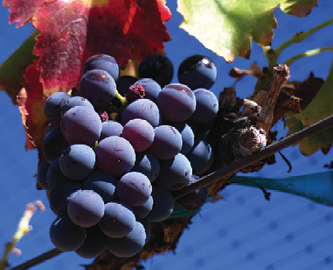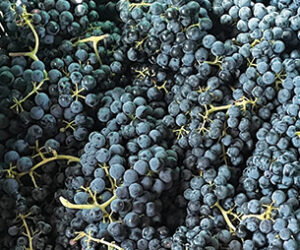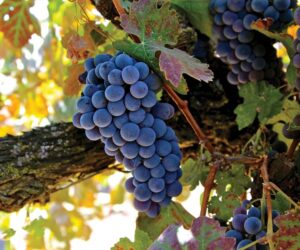 Grenache is one of the most widely planted varieties in the world. Grenache is a fickle grape in the vineyard, which spills over into the winery. It generally over-crops in the vineyard, is sensitive to fungal and pest pressures, has poor color and tannin structure, oxidizes easily, and tends to produce overly alcoholic wines when it is grown in warmer regions. So what is it about the finicky Grenache that has perpetuated its spread around the world? It is its ability to grow in warm climates, on poor soils, as well as its blending capabilities that give Grenache its status.
Grenache is one of the most widely planted varieties in the world. Grenache is a fickle grape in the vineyard, which spills over into the winery. It generally over-crops in the vineyard, is sensitive to fungal and pest pressures, has poor color and tannin structure, oxidizes easily, and tends to produce overly alcoholic wines when it is grown in warmer regions. So what is it about the finicky Grenache that has perpetuated its spread around the world? It is its ability to grow in warm climates, on poor soils, as well as its blending capabilities that give Grenache its status.
There are two plausible but conflicting theories as to the origins of Grenache. The first is that it originated in the Aragon region of northern Spain and then spread to southern France and the Italian island of Sardinia. The other school of thought is that it originated on Sardinia, where it is known as Cannonau, and then spread to the Aragon region sometime in the 14th or 15th century. Either theory seems plausible, with the common denominator being the spread of the Kingdom of Aragon coinciding with the distribution of the grape. By the 18th century, the grape had spread throughout the Iberian Peninsula and to southern France, specifically the Languedoc and Provence. In the early 19th century, with so much westward expansion, the varietal was introduced to Australia and then to California a couple of decades later and the grape thrived in the hotter climates.
In France, Grenache was the second most widely planted grape after Merlot, according to 2007 data. At that time, there were about 240,000 acres planted in the country, and about 40,000 acres in the Roussillon region alone. Surprisingly, there are as extensive Grenache plantings in Spain as there are in France.
In California, there are about 7,000 acres of Grenache, most of it planted in the hot, dry conditions of the southern San Joaquin Valley in the counties of Fresno and Madera. Australia once had extensive plantings, but that number was surpassed by Syrah (Shiraz) and Cabernet Sauvignon in the 1960s. Today, Grenache accounts for about 2% of the Australian wine industry.
Grenache is known by many names, and its synonyms are mostly endemic to the European regions. In this column I will focus on the red variety of Grenache, but the name Grenache doesn’t necessarily mean we are talking about only the red version. Once the variety moved away from Europe, it took on the name Grenache. Dating back to its origins, it was known as Tinto Aragonés, or translated “red of Aragon.” In Spain, it is called Garnacha, in Catalan, Garnatxa, and commonly here in the United States, Grenache Noir. As we’ve seen with many varietals, there are many local synonyms. Two examples include Navarra and Roussillon Tinto, the former referring to the Spanish Denominación de Origen (DO) adjacent to the Aragon region, and the latter the former historical county of the Principality of Catalonia in extreme southern France. The other local synonyms are too numerous to name here. At last look there were more than 50 different synonyms.
These local synonyms are not to be confused with the white mutant of Grenache, which is appropriately named Grenache Blanc. Despite the extensive plantings in Europe, it was not known to the United States market until the 1990s when the first cuttings from Château Beaucastel were imported and cleared for planting. It was not until 2001 that the then Bureau of Alcohol, Tobacco and Firearms (BATF), which is now known as the Tax and Trade Bureau (TTB), recognized the varietal. Until its official government recognition in the United States, it could only be called Grenache. Today, there are only 160 acres of Grenache Blanc planted in California, and 100% of these legal cuttings come from the original importation from Tablas Creek Vineyards in Paso Robles, California. Most of the Grenache Blanc is blended with Roussanne. In France, Grenache Blanc is a major component of the white wines of Châteauneuf-du-Pape and Côtes du Rhône appellations. You will also see it blended with Marsanne and Viognier, the other notable Rhône Valley white grapes. Grenache Blanc is straw-colored and produces wines that are high in alcohol, with crisp acidity even in the warmer growing regions.
The nose has bright green apple and mandarin orange aromas, with clean flavors of more green apples, mineral and a touch of peach. There are also separate varieties of Grenache Gris and Grenache.
In the vineyard, Grenache is extremely vigorous and needs a long growing season to mature all of its fruit. In some cases, the yield on vines is upwards of 15 to 18 tons per acre. Typical of many varieties, one year may produce a banner crop, while the next year yields may be half that. This vigor leads to a tendency to over crop, which results in fruit that is lacking in color development. This poor color translates directly into the wines made from it. Therefore, some degree of crop management is needed in order to produce the best fruit. I have seen instances where one Grenache vine held more than 50 pounds (23 kg) of fruit. The sheer density of the clusters prevents light from striking the berries uniformly, and this results in uneven color development and ripening. Fruit from over-cropped vines is also poor in acid structure with bland flavors. That said, Grenache is one of those varieties that must be made in the vineyard.
From a winemaker’s perspective, the concept of getting good fruit certainly makes the process of making wine easier. So rather than discuss how to make Grenache in the winery, let’s focus on how to make it in the vineyard. For Grenache Noir, only the grapes of the highest quality are made into wines that are 100% varietal. To get the best quality grapes, growers and winemakers should focus on canopy, water and fruit management techniques. Almost everywhere Grenache is grown, the vines should be trellised so that the fruit can hang free and receive indirect sunlight. For the best fruit and chance to make the best wines, remove the leaves in the cluster zone to promote more light penetration. This should be done early in the season, albeit being careful to not completely expose the fruit to direct sunlight. This risks the danger of sunburn. Withholding water after veraison will stress the plants somewhat and, in some cases, enhance color development. For example, for soils here in the Davis, California area, the water cutback can be as much as 50%. The water table and soil holding capacity of a specific site will dictate how much cutback can be tolerated. Crop thinning should take place about two to three weeks after veraison by removing clusters that look behind. Look at the difference in color and between the clusters and keep the darkest clusters. Also look at the cluster’s attachment point on the cane — it should look woody. If it is still green, remove the cluster. Perhaps removing one or two wings will allow the clusters to hang freely. Without crop thinning, the dense cluster leads to conditions that are optimal for fungal disease.
Because of extensive worldwide plantings, it is no wonder Grenache has many wine styles. As a strict varietal, the wines it produces tend to oxidize easily. Research shows that the variety can have high levels of the browning enzyme, polyphenol oxidase, and the vines can have a relatively short life. With respect to color, hopefully you have selected grapes with good color and can keep the fermentation between 85-88 °F (29-31 °C) to promote color extraction. At peak fermentation, punch down the cap up to four times a day to keep it wet. After both primary and the malolactic fermentation are complete, work to get your sulfur dioxide levels stable.
Using oak barrels can also help stabilize the color you fought hard to get. All these techniques are useful to attain a great wine, but in the end, winemakers have long conceded that the best use for Grenache is for blending, so do not be disappointed if you get mixed results and remember that this wine is best made in the vineyard. As a blender, the grape adds fruitiness and alcohol influence without much tannin contribution, which is very desirable in some cases. The grape makes up 80% of the dry red blends of Châteauneuf-du-Pape (the other varieties used being Mourvèdre, Cinsault, Syrah, or Carignan mixed in various proportions). On the other side of the world in the southern hemisphere it is blended with Syrah and Mourvèdre as part of the Australian “GSM” brands (GSM stands for Grenache-Syrah-Mourvèdre). Historically, it was the backbone of Australian Port-style wine. The rosé styles of France’s Tavel and Lirac appellations use Grenache as the principle component. In Spain, Gar-nacha is blended with Tempranillo to make the wines of the Rioja Denom-inación de Origen Calificada (DOC). You will also find dry red wines and rosé styles around the Mediterranean from Morocco, across northern Africa to Israel and circling back around to Greece and Italy. In California, given its inherent benefits as a blender, the fruit from the San Joaquin Valley is generally blended into lower tier wines. The Rhone Rangers, an advocacy group of mostly (but certainly not exclusively) California winemakers, has promoted Grenache, as well as the other Rhône varietals, and these days Grenache receives better notoriety than just jug wine status. There are plantings in California’s Central Coast, Livermore Valley and now in Washington State. At the Rhone Rangers’ annual tasting in San Francisco, you will find many fine examples of Grenache and its blends.
Grenache Recipe
yield: 5 gal/19 L
Ingredients
• Grenache juice concentrate, ~68-70 °Brix (5 cans, 46-oz.)
• Distilled water, 3.5 gallons to dilute concentrate.
• 10% potassium metabisulfite (KMBS) solution. Weigh 10 grams of KMBS, dissolve into about 50 milliliters (mL) of distilled water. When completely dissolved, make up to 100 mL total with distilled water.
• 5 grams EC-1118 (Lallemand, Scott Labs). Premier Cuvée can be used as a substitute.
• 5 grams Di-ammonium Phosphate (DAP)
• 5 grams Go-Ferm
• 5 grams Fermaid K (or equivalent yeast nutrient)
Other equipment or needs:
• 6-gallon (23-L) food-grade plastic bucket for fermentation
• 5-gallon (19-L) carboy
• (1 or 2) 1-gallon (3.8-L) jugs
• Racking hoses
• Inert gas (nitrogen, argon or Carbon dioxide)
• Thermometer capable of measuring between 40-110 °F (4-43 °C) in one degree increments.
• Pipettes with the ability to add in increments of 1 milliliter.
• Clinitest® tablets
• Ability to warm ~4 gallons (15 L) of water to 60-65 °F (15-18 °C).
• Ability to maintain a fermentation temperature of 70-75 °F (21-24 °C). TIP: Prior to harvest, buy several one-liter bottles of water, drink the water and replace with distilled water and freeze. Use a 33-gallon (125-L) plastic can as a water bath. Place the ice blocks in the water to maintain a relatively constant temperature. This will be your refrigeration system for peak fermentation. If you have other means to keep things cool, of course use that. Alternatively, you may have a need to keep it warm. In this case, wrapping the bucket/carboy with an electric carboy wrap (available at most home winemaking outlets) works well.
Step by step
1. Clean and sanitize all your winemaking tools, supplies and equipment.
2. Warm water to about 65 °F (18 °C). You will use 3.5 gallons (13 L) to dilute the concentrate.
3. Add five cans of juice concentrate, using the warmed water to completely dissolve remaining concentrate in the can. Mix well. In the end, you will have about 5.5 gallons (21 L) of juice in the bucket at about 22.5 °Brix.
4. Dissolve the DAP in as little distilled water as is required to completely go into solution (usually ~20 mL). Add to juice and mix.
5. Prepare yeast. Heat about 50 mL distilled water to 108 °F (42 °C). Mix the Go-Ferm into the water to make a suspension. Measure the temperature. Pitch the yeast when the suspension is 104 °F (40 °C). Sprinkle the yeast on the surface and gently mix so that no clumps exist. Let sit for 15 minutes undisturbed. Measure the temperature of the yeast suspension. Measure the temperature of the juice. You do not want to add the yeast to your cool juice if the difference in temperature exceeds 15 °F (8 °C). To avoid temperature shock, acclimate your yeast by taking about 10 mL of the juice and adding it to the yeast suspension. Wait 15 minutes and measure the temperature again. Do this until you are within the specified temperature range. Do not let the yeast sit in the original water suspension for longer than 20 minutes. When the yeast is ready, add it to the fermenter.
6. You should see signs of fermentation within about one to two days. This will appear as some foaming on the juice.
7. Monitor the Brix and temperature twice daily during peak fermentation (10-21 °Brix). Maintain temperature between 70-75 °F (21-24 °C).
8. At about 19 °Brix, slowly sprinkle in the Fermaid K and mix. This can cause extreme foaming and overflow.
9. The wine is consisidered dry, or nearly dry when the Brix reached -1.5 °Brix or less. Measure the residual sugar using the Clinitest®. If the result is greater than 0.5% and there are no signs of fermentation, move on to the next step.
10. Inoculate with your malolactic (ML) bacteria. Check the manufacturer’s instruction on how to prepare and inoculate. Monitor the ML fermentation using a thin layer chromatography assay. Follow the instructions included in the kit.
11.When the ML is complete, Add 3 mL of fresh KMBS (10%) solution per gallon of wine. This is the equivalent to ~40 ppm addition.
12. Leave the wine in a cool place to settle.
13. Consider adding some French and American oak chips, but do not treat the entire lot of wine. Instead, break down the 5 gallons (19 L) into smaller vessels and treat them as fractions to blend back later.
14. After two weeks, test for pH and SO2 adjust the SO2 as necessary to attain 0.8 ppm molecular SO2. (There is a simple SO2 calculator on the Web at www.winemakermag.com/guide/sulfite). Check the SO2 in another two weeks and adjust. Once the free SO2 is adjusted, maintain at this level. You’ll just need to check every two months or so, and again before racking. Also check your acidity and record the results.
15. Rack the wine clean twice over four to six months to naturally clarify.
16. Once the wine is cleared, about six months after the completion of fermentation, it is time to move it into the bottle. Make the project fun by having a blending party to integrate the oak fraction back into the free run. You may not need it all, use your judgment and make what you like.
17. If all has gone well to this point, you are ready to bottle. You may choose to filter at this point, but that is your decision as the winemaker. Be sure to maintain sanitary conditions while bottling. Once bottled, you’ll need to periodically check your work by opening a bottle to enjoy with friends.







